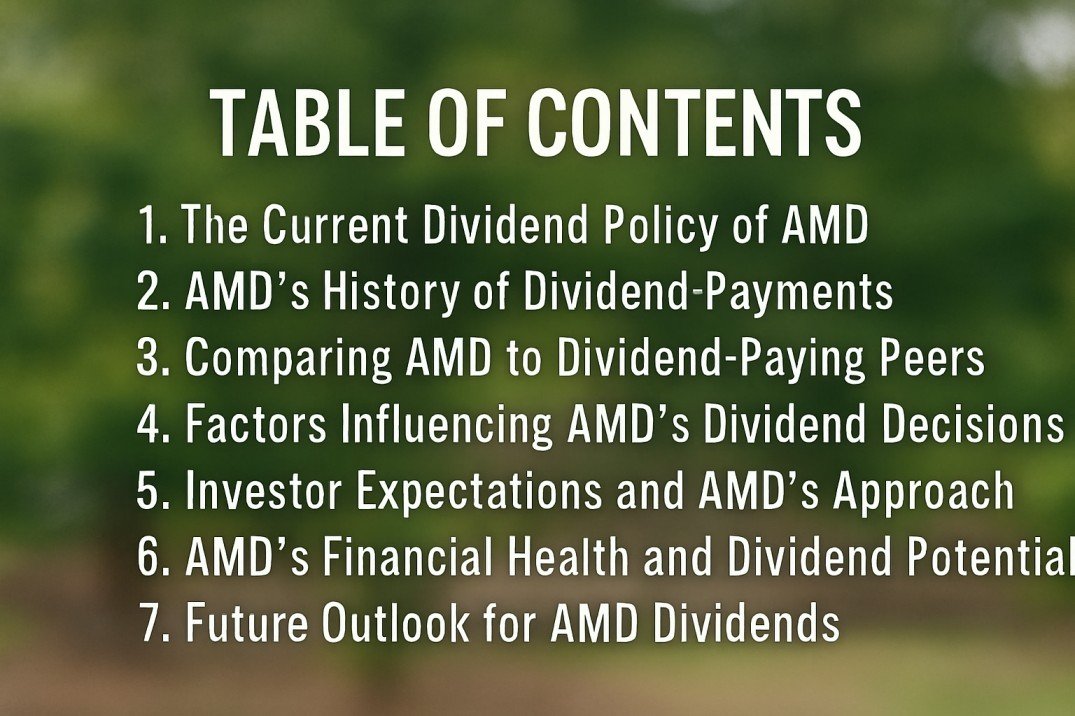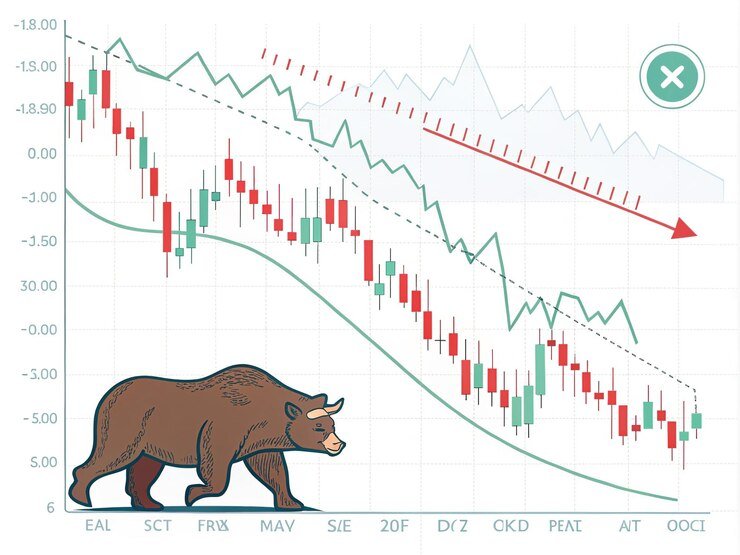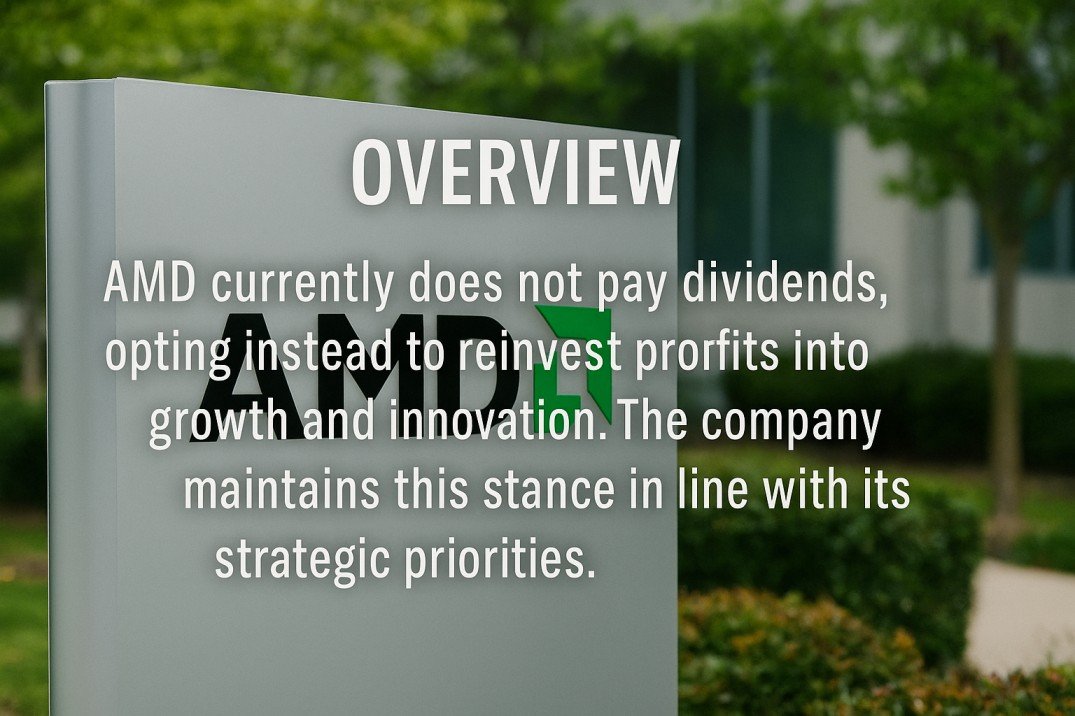Introduction: Why the Question “Does AMD Pay Dividends” Matters Today
In the world of investing, one question has consistent reverberation with tech stock proponents: “Does AMD pay dividends?”
For investors in non-cash flow investments long-term investors and dividend-focused portfolios, dividends have a meaning of showing a financial level of maturity and loyalty to its shareholders.
The dividend question gets even more convoluted with a fluid and fast-paced company like AMD (Advanced Micro Devices).
AMD is a large player in the semiconductor category, and the way AMD focuses on innovative aggressive growth, and long-term strategic reinvestment policies makes it especially difficult to differentiate between reinvestment of profits and shareholder distributions.
This article presents 7 powerful truths that every investor should know right now about AMD and their stance on dividends, the implications, and what it could mean going forward.
Whether you are an active investor or an inquisitive observer, the answer to “Does AMD pay dividends?”, offers more insight into the organization, its objectives and priorities in 2025.
1. Breaking Down the Basics: What Does AMD Pay Dividends Mean?
At its core, when asking the question “Does AMD pay dividends?”, the answer has much less to do with actual cash payments. It is more about what investors expect from the company in terms of maturity, profitability, and financial discipline.
A dividend is simply a share of earnings that is distributed to shareholders and generally indicates that a business is consistently generating profits.
Consider that not all companies, especially those in a rapidly changing and innovation-driven sector like semiconductors, pay dividends.
AMD has chosen to reinvest its earnings within the company rather than give shareholders cash but has instead reinvested cash into business research, acquisitions and growth.
This type of decision indicates that AMD has a long long-termus on growing the business. For those investors seeking income – this might represent a gap.
But when people ask “Does AMD pay dividends?” it is important to understand what is even meant by the term – it is far more than just numbers, it is also about understanding how AMD wants to create value in the highly competitive technology marketplace.
2. The History Behind the Question: Why Does AMD Pay Dividends Keep Coming Up?
The question, “Does AMD pay dividends?” occurs repeatedly as a result of the changes AMD has experienced during the past ten years.
AMD went from being behind all the major players in Tech such as Intel, to a real player again with cutting-edge CPUs, GPUs and Datacenter products in a period of a few years.
Despite making great strides with growth, AMD has never actually put regular dividend payments into their business plan – this is visibly shocking to many Day 1 investors.
As AMD’s stock has increased and the company continues delivering incredible quarterly reports, new investors naturally think, they are now like their peers and will start to reward their shareholders with a dividend(s).
Instead, AMD has doubled down on reinvestment (by acquiring Xilinx, increasing R&D and taking outside partnerships for manufacturing capacity).
Though it is not only about dividends, this pattern of questions has also demonstrated the desire of shareholders to experience “AMD success” but with returns (thereby not participating fully in realizing AMD’s strategy). 6 Big Reasons Why Is GE Stock Down—And What’s Next!
So the question “Does AMD pay dividends?” lives on as investors stay curious and try to make sense of experience vs AMD’s vision and strategic plan.
3. Does AMD Pay Dividends Because It’s Financially Strong or Cautious?
Interestingly enough, the answer to the question “Does AMD pay dividends” is still “no” because it can’t pay dividends. However, AMD’s financials point to increasing revenues, healthy margins, and strong operating cash flows.
However, they are simply cautious (not in terms of their actual survival) and have been disciplined in capital allocation.
Unlike mature companies in dying industries that pay dividends simply because they do not have any choice, AMD chooses to invest heavily in innovation and long-term competitiveness.
In short, a lack of dividends is not a sign of weakness, but rather a sign of a forward-looking mindset. For AMD, growth is valued more than immediate income for each shareholder.
As a result, a lack of dividends has not hurt AMD, base stock price and strategic acquisitions. So to answer the question: does AMD pay dividends largely because it can? Yes.
Does it pay dividends because it has actively chosen not to based on caution and a future-oriented perspective? Yes.
For AMD, being able to reinvest in itself is the way to create even more value – which we would like the investors to understand crystal clear.
4. Market Comparisons: How Does AMD Pay Dividends Stack Against Intel & Nvidia?
Investors who ask “Does AMD pay dividends?”, might have Intel and Nvidia on their minds, and compare AMD to those companies in interviews — each company has a different dividend strategy (Intel has a strong history of paying dividends, as it offers investors that stability as a mature company and Nvidia does pay dividends but they are not as aggressive as Intel).
AMD has taken a different approach, it has chosen to put every dollar back into product development, acquisitions, and infrastructure improvement, to strengthen its competitive advantage. AMD has taken the most aggressive approach to growth.
Comparing the dividend policies of this group of giants identifies AMD’s strategy: lean, ambitious, and reinvestment. Intel might attract income-generating investors. AMD attracts investors focused on growth.
Within the spectrum of “Does AMD pay dividends?”, it is not simply a yes or no, but a clear definition of priorities in a high-stakes technology arms race.
5. Investor Reactions: What Wall Street Thinks About ‘Does AMD Pay Dividends’
When Wall Street analysts and institutional investors think about the “Does AMD pay dividends?” question, they tend to be fairly sophisticated.
Yes, there are lots of conservative investors who appreciate companies with predictable dividend income, but the understanding around AMD is much larger than simply dividends, and overwhelmingly positive even without dividend payments.
More than they prefer to earn income money — many rapport AMD’s investment strategy to reinvest money back into R&D, partnerships, and markets to expand into and its uptick in momentum in this dynamic marketplace; gaining market share especially bonuses, such as high-performance computing and A.I. Analysts often speak about how AMD has been efficient deploying its capital and has a long-term objective that is certainly not weak.
Several large institutional investment funds do like dividend income where which could sometimes lead AMD to be viewed as a stock not to hold in DIVIDEND INCOME portfolios; certainly not the same with the vast majority of Wall Street thinking about AMD in regards to dividends not being a concern or focus.
Overall, Wall Street has accepted AMD’s no-dividend path to share performance and share price appreciation as it is aligned with growth, “does AMD pay dividends?”, is a very acceptable question to ask, yet this continues to earn Wall Street’s confidence for the sake of long-term potential.
6. Does AMD Pay Dividends in 2025? Here’s the Real-Time Answer
In 2025, the unequivocal answer to “Does AMD pay dividends?” is still no — they have not paid dividends nor initiated a dividend program.
Even with strong financial results, AMD has not distributed profits to shareholders in cash form. A cash payout option is likely not under consideration as AMD has prioritized expanding its technology portfolio, its competitiveness in the AI and data center markets, and continuing the process of putting its recent acquisitions together.
AMD executives continue to reaffirm their focus on long-term value. In their belief, investments in future strategic acquisitions and investments in products, technology, and services should allow for reward and make any appreciation of investments in AMD more worthwhile.
AMD has responded to increased pressure from income and income-oriented shareholders that they are not changing their approach even as the pressure mounts.
Importantly, AMD has not unequivocally said “no” to future dividends – they have said that they will meet with the Board when the time is right for AMD to address its maturity and market readiness.
Therefore, in 2025, if you are asking yourself “Does AMD pay dividends?”, the first reality is to say no – but future dividends can still be an option functioning on how AMD will evolve and grow through the next phase of expansion and growth.
7. The Future Outlook: Will the Answer to Does AMD Pay Dividends Ever Change?
Las preguntas acerca de “Si AMD paga dividendos?” tend to come up with some frequency three years after the Company goes public.
I think if AMD continues to mature and stabilize its revenue streams over the next twenty-four months, the answers to questions about dividend payouts could change — but not yet.
Like many future-orientated companies trying to grow from much smaller beginnings, if AMD maintains growth levels of its high-margin businesses, I wouldn’t be surprised that at some point along that proliferation path, dividends will become a strategic possibility once the board has a better sense of where the company ends up.
No shortage of previous tech behemoths, ranging from Apple Inc., and Microsoft, could testify to this. Both companies never instituted a dividend in their early beginnings and I suspect that AMD could find themselves in a relatively better-purposed position.
If the Company continues to grow as a catalog ecosystem of intellectual property (and so forth), the company has the option, naturally over time, to distribute capital — that could come in the form of dividends. In the short term, you will see the real-time payouts in terms of free cash flow and when or if AMD takes on (and for that matter) grows from capital expenses.
The one thing to look for if you are asking yourselves about dividends is inquiring what management in general has said in writing or spoken about dividends. To sum it up and conclude, AMD does not pay dividends but it hasn’t forever closed the door.
Good odds are high @ the time I write this article, the answer to the inquiry of “Is AMD a dividend stock”, could very well be “yes”; pending the timing, and the vision either coincides; or given the manageability transition to an ultimately successful company, the dividends of cash is an inevitable evolution.
Conclusion: Understanding the Deeper Meaning Behind ‘Does AMD Pay Dividends’
The simple question — “Does AMD pay dividends?” — opens up a larger story about how AMD is thinking about its future, its priorities, and its relationship with its investors.
They have decided, at least for now, not to pay dividends… because they are successful, ambitious, and innovation-driven — not unprofitable. AMD is a visionary technology leader that prioritizes creating long-term value over short-term shareholder payouts.
Growth investors could not ask for more. However, for those looking for dividends, it may simply be a brief pause until AMD is ready to allocate capital to its shareholders.
Ultimately, understanding why “Does AMD pay dividends?” leads us to “NO” today helps us best understand the larger ambition that AMD is executing. It is not about the cash, it is about the confidence, the reinvestment, and building something much bigger for tomorrow.
Disclaimer ⚠️
The information provided by us in this article is for educational and information purposes only. Here we do not give any advice to buy or sell any stock. Before investing in any company, consult a certified financial advisor. All investments are subject to market risks.

